Homemade roast beef sandwich fats are about balance. You want rich flavor, not greasy bites. I’m Edward Hale, born in Istanbul, raised in Texas, where we treat beef with respect. My grandmother taught me to cook with care, and I’ve carried that lesson through years on the line and into my own kitchen.
I don’t follow trends. I focus on real food that tastes great and feels honest. This sandwich is just that. Lean beef, good bread, simple ingredients, done right.
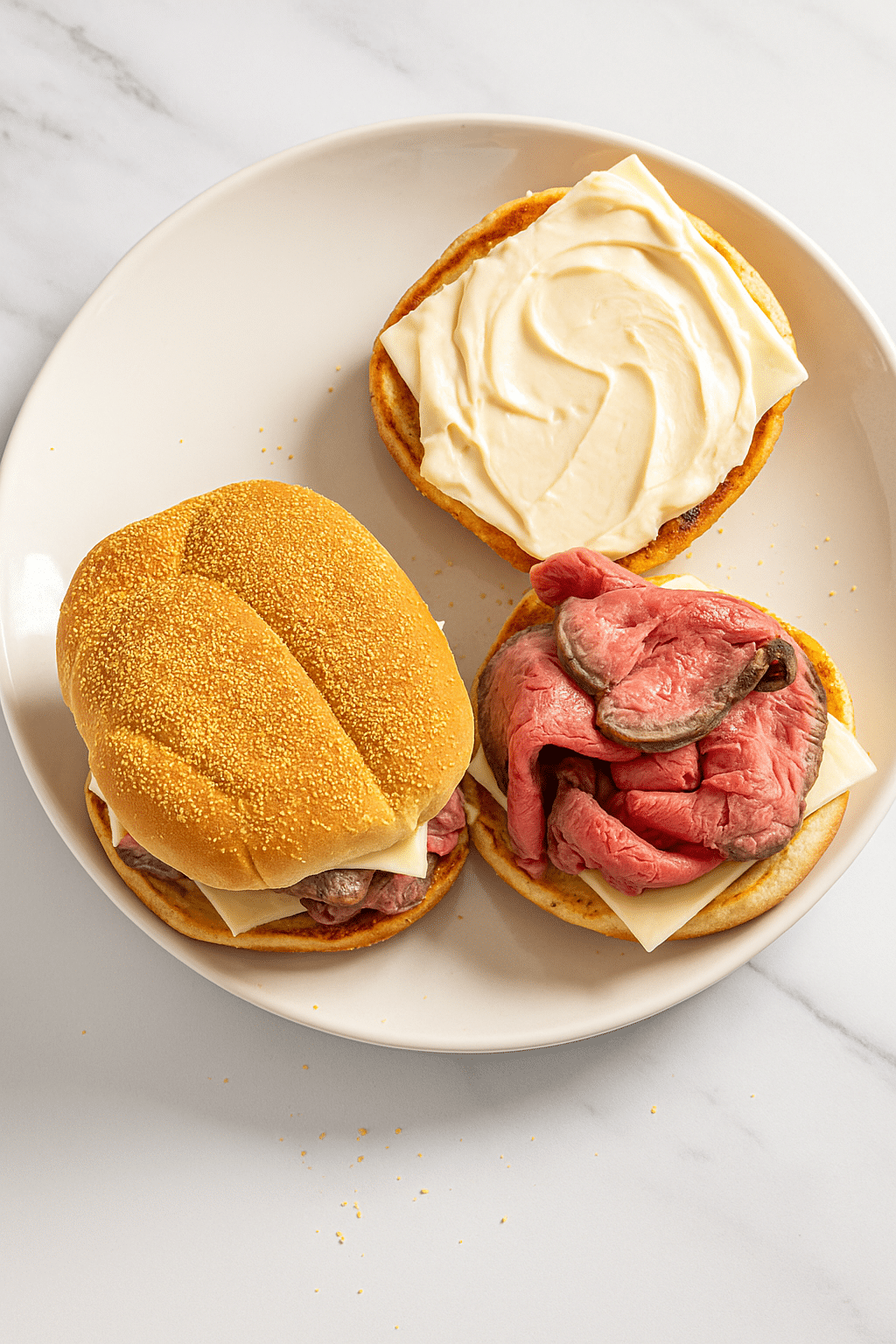
Table of Contents
Pick the Right Beef Cut
Flavor Starts with the Cut
When it comes to homemade roast beef sandwich fats, the cut of beef makes all the difference. You want something lean but still juicy. That’s why I go with eye of round or top round. These cuts give you strong beef flavor without extra grease.
Lean Is the Way to Go
You don’t need heavy fat to get bold flavor. These lean cuts slice up clean and thin, perfect for stacking high on a sandwich. They hold their shape, keep their moisture, and won’t turn rubbery when chilled.
My Advice
Skip the fancy stuff. Stick with round cuts. Leave the thin outer layer of fat intact while roasting to lock in moisture and enhance flavor. It adds just enough richness without making the sandwich greasy. Once cooked, you can trim it off if you like.
Simple beef. Big payoff.
Print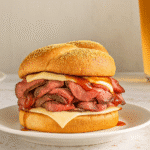
The Truth About Homemade Roast Beef Sandwich Fats You Need to Know
- Total Time: 3 hrs 50 minutes
- Yield: 6 1x
Description
Discover what really goes into the fat content of a homemade roast beef sandwich. Learn how to choose lean cuts, portion ingredients wisely, and keep every bite juicy, satisfying, and better for you.
Ingredients
For the Roast Beef (See Notes):
1 (3-pound; 1.4 kg) boneless top round roast or eye round roast, trimmed and tied at 1-inch intervals (see notes)
4 teaspoons (12 g) Diamond Crystal kosher salt; if using table salt use half as much by volume or the same weight
1 teaspoon freshly ground black pepper
1 tablespoon (15 ml) vegetable oil
For the Sandwiches:
3 tablespoons unsalted butter
6 Kaiser rolls or Bulkie rolls, split open, (see notes)
12 slices American cheese, or another mild sliced cheese, such as cheddar, optional
Mayonnaise (optional)
Homemade or store-bought barbecue sauce or another sauce of your choice (optional)
Optional toppings
Instructions
For the Roast Beef:
Sprinkle roast evenly with the salt and pepper and refrigerate on a wire rack set in a rimmed baking sheet uncovered for at least 1 hour or up to 24 hours.
Adjust oven rack to center position and preheat oven to 225°F (105°C). Place baking sheet with rack and beef in oven and roast until internal temperature registers 115°F (46°C) on an instant-read thermometer at the thickest point, about 1 to 1 1/2 hours.
Just before the roast comes out of the oven, add oil to a 12-inch stainless steel, or cast iron, or carbon steel skillet and heat over high heat until smoking. Add roast to skillet and cook, using tongs and moving roast as needed, until roast is evenly browned on all sides, and internal temperature registers 125°F (50°C), 5 to 7 minutes.
Transfer the roast to a large plate and let cool completely, about 1 hour (if time allows, refrigerate the roast whole until well chilled, at least 2 hours and up to 1 day).
Slice the roast as thin as possible against the grain.
For the Sandwiches:
In a 12-inch stainless steel or cast iron skillet, melt 2 tablespoons butter over medium heat until just melted. Add 2 bun bottoms and 2 bun tops, cut side down, and cook, swirling bread around the skillet frequently, until toasted evenly on one bottom, about 3 minutes. Transfer buns, toasted side up, to a plate and while still hot, add a slice of cheese to each top and bottom. Repeat with remaining 1 tablespoon butter, remaining bun halves, and remaining cheese.Transfer to a plate.
Spread a thin layer of mayonnaise, if using, over bun bottoms. Divide the sliced roast beef and mound it evenly on the roll bottoms (about 6 ounces beef per sandwich). Spread barbecue sauce, if using, or your preferred sauce over the beef and add your favorite toppings. Close sandwiches with bun tops and serve.
Notes
If your top round roast has a fat cap on it, trim the fat cap to 1/4 inch thick.
The cooler the roast is, the easier it will be to slice the beef as thin as possible. If time allows, I recommend making the roast up to a day ahead and refrigerating the roast until chilled, at least 2 hours, before removing the twine and slicing for sandwiches.
- Prep Time: 5 minutes
- Cook Time: 105 minutes
- Category: Proteins
- Cuisine: American
Nutrition
- Serving Size: 6
- Calories: 478kcal
- Sugar: 3g
- Sodium: 2892mg
- Fat: 26g
- Saturated Fat: 12g
- Carbohydrates: 20g
- Fiber: 1g
- Protein: 41g
- Cholesterol: 131mg
Looking for inspiration? Try our Instant Pot Corned Beef.
Prepping and Seasoning the Roast
Start with Salt, Not Sauce
Before anything hits the oven, you’ve got to build flavor. The simplest and most effective step?Start with salt. A generous rub of kosher salt draws out moisture and seasons the roast all the way through, giving you bold, well-balanced flavor. This step helps you control homemade roast beef sandwich fats by drawing out water, not adding extra oil.
Let It Rest, Let It Dry
After salting, place the roast on a rack in the fridge, uncovered. Let it sit there for at least an hour, or better yet, overnight. This creates a dry surface that’ll brown beautifully later.That golden crust is where all the magic happens. It’s the key to rich flavor and a texture you won’t want to miss.
Tie It Up for Even Cooking
If your roast isn’t a uniform shape, it won’t cook evenly, and you could end up with dry or undercooked spots. Grab some butcher’s twine and tie it snugly. A neat, even roast cooks better and slices easier. It’s a small step that makes a big difference when you’re serving this sandwich to someone who expects flavor in every bite.
What to Avoid
Don’t add oil, marinades, or spice rubs at this stage. Keep it simple. Just salt. That way, you keep the fat low and the beef flavor front and center. We’re not masking the meat. We’re respecting it.
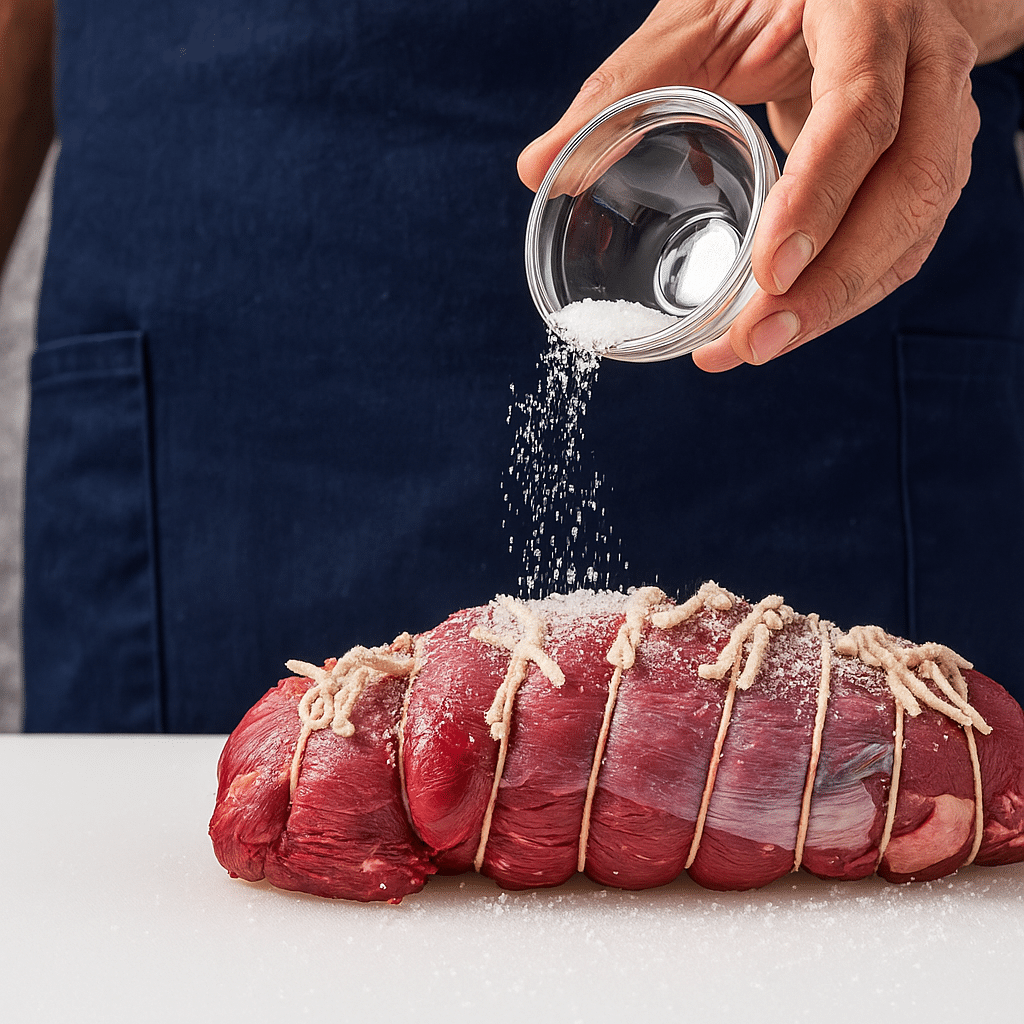
Cooking It the Right Way
Slow Roasting is the Secret
If you want roast beef that’s tender, juicy, and not dripping with grease, low heat is your friend. Set your oven to 225 degrees Fahrenheit. That slow, steady heat gives the roast time to cook gently. It keeps the inside pink and moist while the outside stays from drying out. This is how you manage homemade roast beef sandwich fats without losing flavor.
Don’t Rely on Time Alone
Forget timers. Use a thermometer and check the center of the roast. Once it hits 115 degrees, pull it out. That’s your cue. At this point, the meat is still rare inside, which is exactly what we want before the next step.
Build a Crust with a Quick Sear
Now you bring the flavor home. Get a skillet screaming hot, then sear the roast on all sides. Just a couple of minutes each side is enough. This step gives you that deep brown crust that makes every bite pop with flavor. No extra oil needed. Just heat, meat, and patience.
Why This Method Works
Slow roasting helps the meat cook evenly. Searing adds that final touch, locking in juices and building flavor. The result is beef that’s tender through the center, flavorful on the outside, and balanced in fat. No dry edges. No greasy puddles. Just the kind of beef that belongs on a sandwich worth eating.

Cooling and Slicing
Rest First, Slice Later
Once your roast comes off the heat, give it time to cool down. Cutting too soon is a common mistake. Letting the meat rest gives the juices time to settle, so each slice stays moist and neat when you cut into it. It also firms up the roast, which makes it way easier to slice thin, especially when you’re working with lean cuts.
Chill to Get the Right Texture
Pop the roast in the fridge once it cools a bit on the counter. Cold beef slices smoother and holds together better in a sandwich. It also lets you control how much fat shows up in every layer. When you care about homemade roast beef sandwich fats, this step is where precision starts.
Use the Right Blade
You don’t need fancy tools. A sharp carving knife or even a good bread knife will do the job. Just make sure it’s sharp. And always cut against the grain. That’s the trick to getting tender slices that aren’t tough or stringy. Slow, steady strokes will take you further than pressing hard and rushing through it.
Slice Thin, Keep It Clean
Thin slices give you a better bite. They lay flat on the bread, soak up the juices just enough, and let the beef flavor come through without making the sandwich heavy. That’s what we’re going for here. Every bite is clean, well-balanced, and satisfying, from the first forkful to the last.
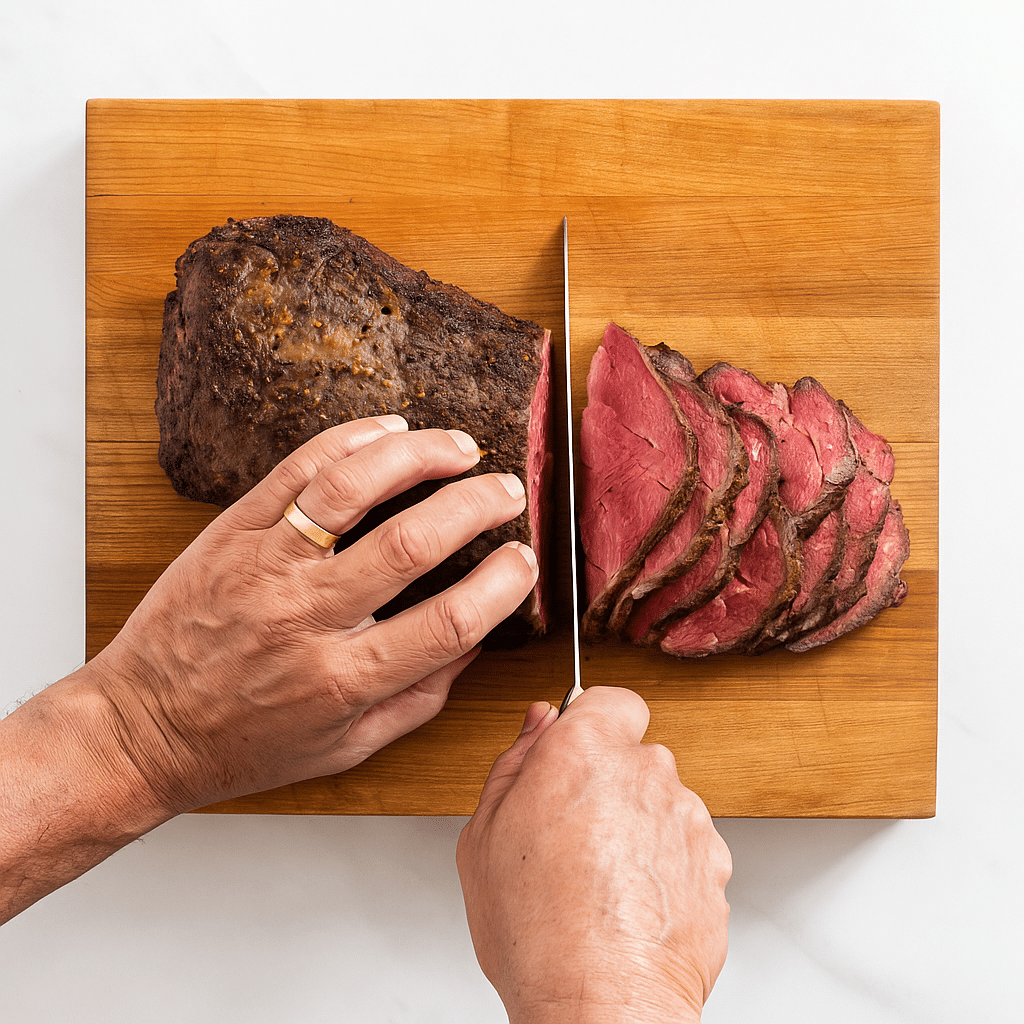
Choosing the Right Bread
Not Just Any Bread Will Do
You’ve spent time getting the beef just right, so don’t throw it on a soft, soggy bun. The bread needs to hold up to the juices, the heat, and the layers. For this kind of sandwich, structure matters. It’s not just a delivery system. It’s part of the experience.
Go with Rolls That Have Backbone
I usually go for a Kaiser roll or a classic New England-style bulkie roll. They hold up well and soak in just the right amount of flavor. They’ve got a soft interior with enough strength on the outside to hold their shape. When toasted, they give you a light crunch without falling apart. That texture helps balance the lean beef, especially when you’re keeping an eye on homemade roast beef sandwich fats.
Skip the Fluff
Bread like brioche or soft white sandwich slices may taste good on their own, but they can’t stand up to the beef. You’ll end up with a sandwich that falls apart halfway through. And dry, crusty breads? Those make each bite a workout. You want something sturdy but still tender when toasted.
Toasted is Better
Always toast the cut side of the bread. A little butter in the pan gives you flavor, structure, and just the right surface to catch a bit of melted cheese. It’s not about making it fancy. It’s about making every part count.
Choosing the Right Cheese
Keep It Mild, Keep It Melty
Now let’s talk cheese. You don’t need something loud or overpowering here. The beef is the star, so the cheese should support it, not steal the spotlight. When building a sandwich with lean cuts, like the kind we use to manage homemade roast beef sandwich fats, the cheese adds just enough richness to round everything out.
My Go-To Choices
American cheese melts like a dream and has a mellow flavor that blends in without making noise. Mild cheddar is another solid option. It gives you a little more edge without taking over. Either one gives you that creamy, smooth bite that balances the roast beef without piling on extra fat.
A Slice Is All You Need
You don’t need to stack the cheese. One slice on each half of the bun does the trick. That’s enough to soften into the bread when toasted and wrap around those beef slices like a warm blanket. It’s comfort food done smart.
Melt It Just Right
Add the cheese right after toasting the buns. The heat from the pan and the warm bread will soften it just enough to cling. No microwave, no fancy broiler, just a little timing and a hot skillet.
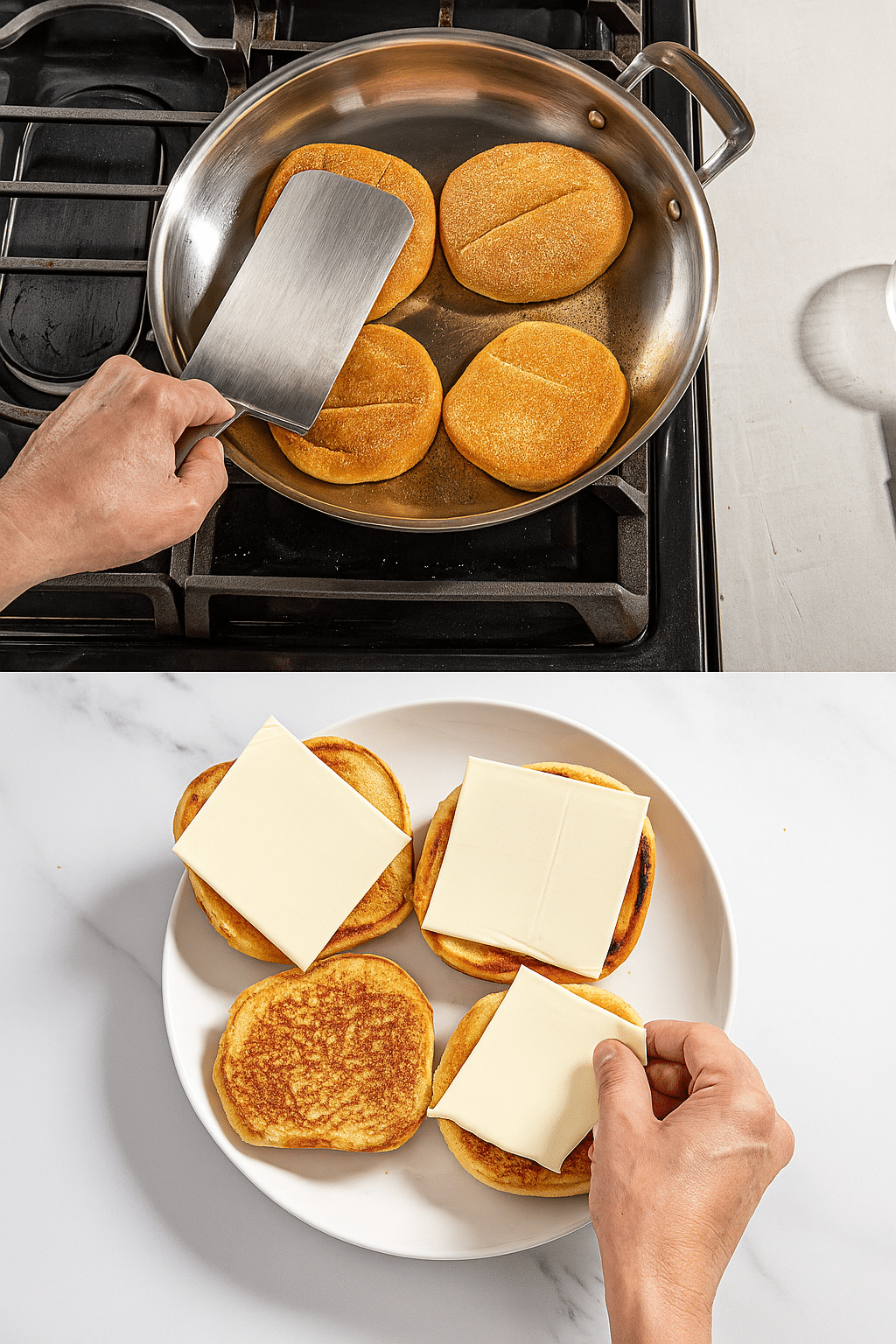
Assembling the Sandwich
Respect the Build
You’ve seasoned the roast, cooked it with care, sliced it thin, toasted your bread, and picked the right cheese. Now it’s time to put it all together. This isn’t the moment to rush. Assembly matters. A sloppy build leads to a sloppy bite.
Start with the Toasted Bun
Grab your toasted rolls, warm and golden from the skillet. Lay the cheese-covered sides facing up. That little bit of melted cheese will help hold the sandwich together while adding flavor in every layer.
Add the Beef Like You Mean It
Pile on the roast beef, don’t be shy. You want volume, but not chaos. Lay the slices gently, overlapping them so they fold naturally. This gives the sandwich that nice layered bite and lets the heat from the beef help the cheese melt a little more.
Keep the Fats in Check
One of the best parts of this method is how it respects the balance of homemade roast beef sandwich fats. No oily drips. No greasy feel. Just clean, juicy beef layered over a sturdy, toasted roll with a bit of creamy cheese to hold it all together.
Time to Close It Up
If you’re adding sauce, now’s the time. A swipe of mayo, a drizzle of your favorite barbecue sauce, or a touch of mustard works great. Then crown it with the top bun and give it a gentle press. That’s it. No towers. No mess. Just a proper sandwich made right.
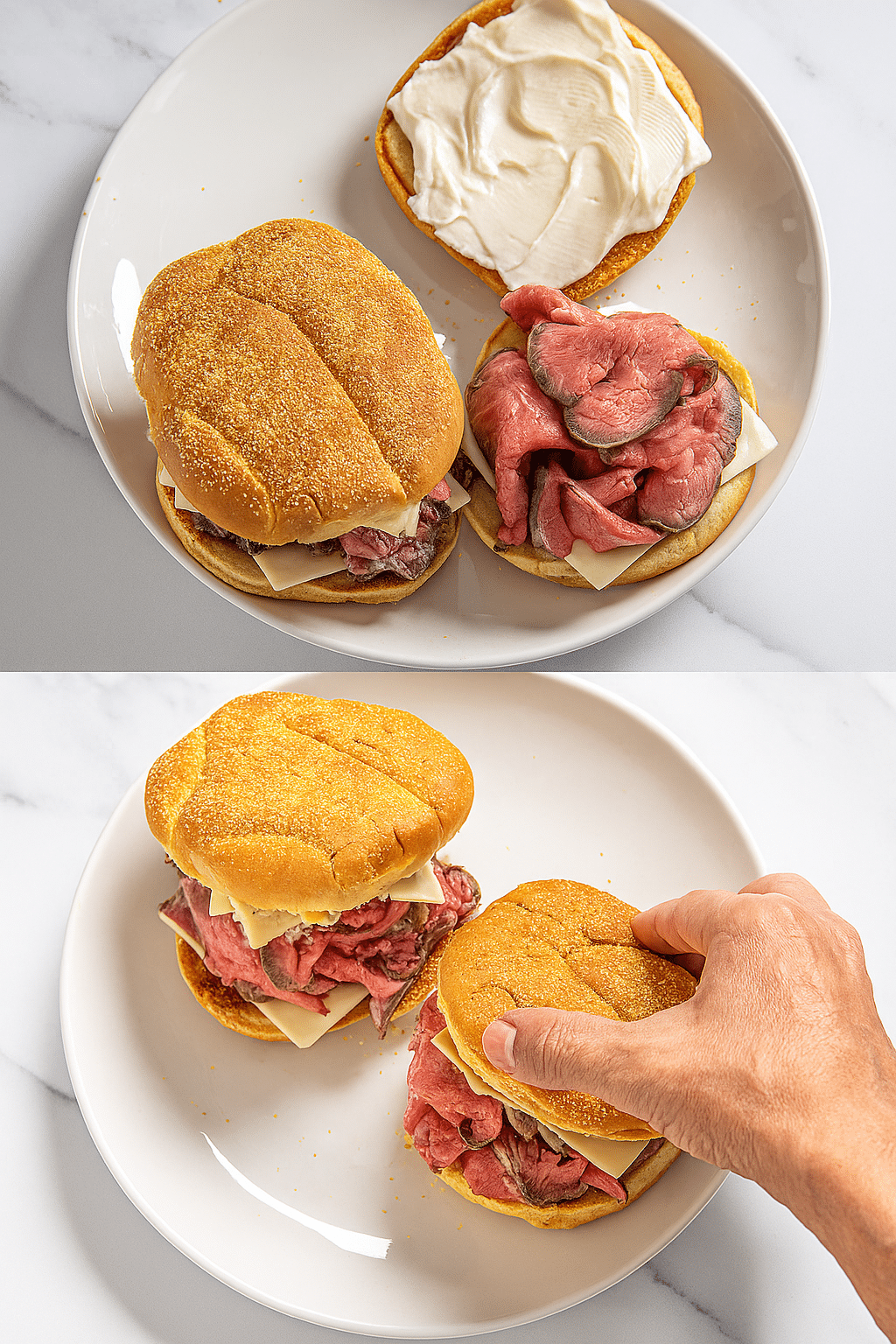
Toppings That Add Without Overdoing It
Let the Meat Do the Talking
With tender beef, melted cheese, and toasted bread, you’ve got a timeless combo that packs bold flavor into every single bite. That alone makes a solid sandwich. The toppings should bring support, not steal the spotlight. When you’re using lean cuts and managing homemade roast beef sandwich fats, the last thing you want is to pile on ingredients that throw off the balance.
Use Light Touches with Purpose
A little mayo can bring creaminess. Barbecue sauce adds sweetness and depth. Dijon mustard brings a clean, sharp edge. These are flavor tools, not cover-ups. Choose one or two toppings at most, and use just enough to enhance the beef without overpowering it.
Add Crunch the Right Way
Soft bread and tender beef are great, but a bit of texture never hurts. Try thin pickles for a vinegary snap. A handful of shredded lettuce gives freshness without bulk. If you’re feeling bold, add a few potato chips for that salty crunch. Keep it playful, but thoughtful.
Keep it Light and Honest
Lean beef is already doing the hard work. If you overload the sandwich, you risk making it heavy. Toppings should complement, not compete. You’re not building a mountain. You’re building a balanced, satisfying bite.
When you pay attention to the details, even the extras can feel like part of the core. That’s how you respect your ingredients and keep control over homemade roast beef sandwich fats while still making something worth craving.
For more recipes, follow me on Pinterest or Instagram
Conclusion
A great roast beef sandwich doesn’t need to be complicated. It just needs the right beef, quality bread, real cheese, and a little care. When you start with lean cuts and put thought into each layer, you get a sandwich that’s full of flavor and still keeps homemade roast beef sandwich fats in check.
Every step in this recipe matters. From the way you season the meat to how thin you slice it, you’re making choices that shape the final bite. Managing homemade roast beef sandwich fats isn’t about taking away flavor. It’s about building it smarter.
This approach is all about respect. Respect for the beef, for the process, and for the person you’re serving. Make this sandwich once, and you’ll taste how homemade roast beef sandwich fats can be handled with care while still delivering a bold, satisfying meal.
FAQs About Roast Beef Sandwich Fats
How much fat is in a roast beef sandwich?
It depends on how you build it. A sandwich made with lean cuts like top round or eye of round, paired with light cheese and a sturdy roll, typically lands around 25 to 30 grams of total fat. Using your own roast and skipping heavy sauces helps you keep the fat under control.
Is roasted beef high in fat?
Not always. It all comes down to the cut. A top round roast is naturally lean, while something like ribeye carries more marbling and fat. When you’re focused on homemade roast beef sandwich fats, choosing leaner cuts gives you full flavor with less grease.
Is a roast beef sandwich unhealthy?
Not if you make it right. A sandwich built with quality beef, modest cheese, and smart portions can be a balanced, protein-rich meal. Keep your ingredients simple, skip the overloaded sauces, and you’ve got something you can feel good about eating.
Is deli roast beef high in fat?
Store-bought deli roast beef often contains more fat than homemade versions, especially if it’s processed or made with fattier cuts. When you roast and slice your own, you get to choose the beef and trim it yourself. That’s the best way to manage homemade roast beef sandwich fats and keep the meal cleaner.





